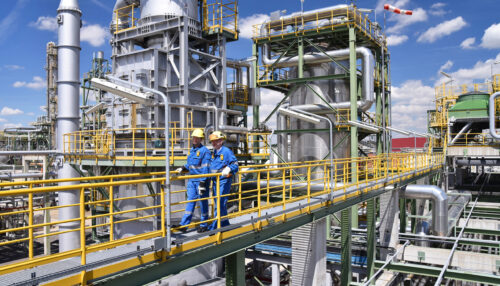
Understanding AI’s Role in Evolving Process Hazard Analysis
July 24, 2025
By: Kirk Busby
One of the most critical tools in ensuring operational safety in high-risk industries such as oil and gas, chemicals, pharmaceuticals, and manufacturing is a Process Hazard Analysis (PHA). Traditionally, PHAs are collaborative, team-driven processes that reflect deep expertise but can also be time- and resource-intensive. But the rapid advancement of artificial intelligence (AI) is providing a new method to transform how we approach hazard analysis.
What is Process Hazard Analysis?
PHA is a structured framework for identifying potential process-related hazards and evaluating their risks. It includes methodologies like HAZOP (Hazard and Operability Study), What-If Analysis, Failure Mode and Effects Analysis (FMEA), and Layer of Protection Analysis (LOPA). These techniques rely heavily on expert knowledge, historical data, and systematic reviews of process diagrams and operating procedures.
While highly effective, traditional PHA methods can be time-consuming, labor-intensive, and prone to human bias or oversight, especially in complex systems with countless variables and interactions. AI can provide significant improvement to these challenges in the PHA process.
How AI is Enhancing PHA
AI technologies, particularly those involving machine learning (ML), natural language processing (NLP), and data analytics, offer powerful capabilities to augment and streamline the PHA process. Here are some ways AI can make an impact:
1. Automated Data Analysis and Pattern Recognition
Industrial processes generate vast amounts of data, including transmitter readings, control system logs, maintenance reports, and incident records. AI excels at processing data at scale. Machine learning algorithms can detect patterns and correlations that human analysts might miss. For example, an AI system could analyze historical incident or mechanical integrity data to identify common root causes or precursor conditions that precede specific hazards.
This data-driven insight can be used to inform risk assessments, helping teams focus their attention on the most critical areas. For example, a PHA Team could utilize AI to parse historical maintenance data for the system under review to quickly identify low reliability or troublesome equipment without the need to manually review thousands of individual work orders. This insight can allow teams to greatly improve accuracy when ranking potential hazards.
2. Natural Language Processing for Documentation Review
PHA teams often need to sift through mountains of documentation: procedures, equipment manuals, past reports, regulatory requirements, etc. Natural Language Processing (NLP), a subset of AI focused on understanding human language, can automate much of this review. AI tools can quickly extract relevant information, flag inconsistencies, and highlight areas of concern.
Given enough quality data inputs, some advanced systems can even suggest hazard scenarios based on contextual analysis of these documents. This analysis can then be used to compare similar scenarios, which can drive consistency between hazard scenarios within a single PHA, across multiple PHAs at a given facility, or even across the full breadth of facilities within a larger company.
3. Knowledge Retention and Transfer
One of the challenges in PHA is the reliance on experienced personnel. As seasoned engineers and operators move to different roles, their tacit knowledge risks being lost. AI can help capture and retain institutional knowledge by learning from past PHA studies, incident investigations, and operational data. Over time, AI systems can build a repository of lessons learned and best practices, supporting consistency and knowledge continuity across teams and projects.
Challenges and Considerations
Despite its promise, integrating AI into PHAs isn’t without significant challenges. Primarily, AI systems are only as good as the data they’re trained on. Poor-quality, incomplete, or biased data can lead to flawed insights. Moreover, AI models can be opaque, offering conclusions without clear explanations, which can be a barrier in safety-critical decisions where transparency is crucial.
There’s also a cultural shift required. Engineers and safety professionals may be skeptical of relying on AI for critical judgments. Ensuring proper validation, regulatory compliance, and human oversight remains essential.
The Future of AI in PHA
The integration of AI into PHA is still in its early stages, but its trajectory is clear. As AI tools become more sophisticated and more deeply embedded into industrial software ecosystems, we can expect:
- More efficient PHA sessions
- Improved consistency
- Reduced reliance on manual data collection
Ultimately, AI won’t fully replace the human judgment central to a PHA; it will enhance it. By automating routine tasks, surfacing hidden risks, and providing decision support, AI allows safety professionals to focus on what they do best: thinking critically, innovating responsibly, and protecting lives.
Trusted Safety Solutions for a Changing Risk Landscape
Process Hazard Analysis is a cornerstone of industrial safety, and organizations that embrace AI now—despite current challenges—will gain efficiency, deeper risk insights, and a stronger foundation for navigating tomorrow’s safety landscape. AI integration with facility data and hazard analysis is still evolving, and Montrose is excited to partner with companies to explore and expand its potential in Process Safety Management. Backed by 30+ years of experience across a wide range of industries, our team helps clients identify potential hazards, conduct thorough analyses of systems and operations, and develop actionable plans and procedures to ensure long-term safety. Our goal is to protect your company, your employees, and the communities in which you operate.
Ready to strengthen your process safety program? Partner with Montrose to explore how AI and proven expertise can elevate your PHA.
 Kirk Busby
Kirk Busby
Line Manager – Process Safety Management
Kirk Busby has over 10 years of experience in all aspects of Risk Management Plan (RMP) and Process Safety Management (PSM) consulting, program development, and maintenance, with a special emphasis on Process Hazard Analysis. He is a Certified facilitator of Process Hazard Analysis (PHA) and Layer of Protection Analysis (LOPA) studies and auditing programs and has participated in Hazard Analyses for a wide variety of industries, including oil and gas production, refining, chemical manufacturing, and ammonia refrigeration.




